Prayers of the Faithful
-
Can you all stand another question from poor ignorant Joan?
For the First Friday Novus Ordo Masses at our diocesan chapel (I won't say "in Latin" anymore, Frogman Jones!), we are incorporating more chant, and Monsignor would like the Prayers of the Faithful to be cantored in English, followed by the "ut nos exaudire digneris" and "te rogamus, audi nos" as in the Parish Book of Chant p. 9.
After reading the wonderful tutorials on chanting Gospels & Epistles, I wonder if there are similar guidelines for chanting Prayers of the Faithful. I usually just stay on one note and go up or down a little bit when the text seems to call for it and it "feels right," :P but since joining this group I realize now I'm probably doing it (and so many other things!) wrong.
Thanks,
Joan -
The Prayer of the Faithful is pretty much free-form, so what you're doing now is fine.
If you want a model to follow, the 1999 edition of Iubilate Deo has four verbal formulas, each with its own melodic formula:
1) ..., Dominum deprecemur. Te rogamus, audi nos.
2) ..., adiuvare digneris. Kyrie, eleison.
3) ..., Dominum oremus. Christe, audi nos.
4) ..., Dominum oremus. Domine, miserere.
The first one uses a drop of a third at the flex:
(I put in the sample English petition.) -
There is a book "De oratione communi seu fidelium" from the Vatican, and I wonder if it would have any help. I don't seem to be able to locate a copy of it. Anyone know if this could be helpful. I also don't know why the "ut nos" would be put before the "exaudire digneris". Such subjunctive don't need to be subordinated.
-
The Graduale Simplex (451-453) and the Ordo Cantus Missae (no. 504 bis) both have eight melodic formulas, only differing in the acclamation of formula B (the Simplex here has 'Te rogamus audi nos' while the Ordo has 'Kyrie eleison'). They are also, in English, in By Flowing Waters (no. 637-644). Judging from the texts and the example given by chonak, the four formulas in Jubilate Deo seem to be identical to the first four formulas of the Ordo.
I just wonder: how does the priest sing the invitation to pray and the concluding prayer? Are there any melodic formulas for these, fitting the eight formulas for the petitions and short acclamations? -
Thank you! Chonak, what does the open punctum mean? I've seen it before, but it doesn't seem to be listed in neume charts such as the one in the back of PBC. It looks like a marker for free-flow chant of many syllables on the same pitch, but that wouldn't fit its appearance on the "good deed" flex in your example.
-
Well, now I realize that I didn't pick a very suitable sample text.
The pattern in the example in Iubilate Deo has no sample text, and it ends on "do-la-la", The "do" note has a stress mark above the staff, indicating an accented syllable. Then it descends to "la" for the one or two unaccented syllables that follow.
In Latin, that covers all the possibilities, but in English, it's possible that the last accented syllable has no unaccented syllables following it.
The text above illustrates the problem; it has accents on "ev-ery good deed".
So you could (a) make up a rule to handle that case, or (b) write the text of any petitions to avoid ending on an accented syllable! I recommend the latter. :-) -
Ahhhh... thank you! Very interesting!
-
Thanks, dvalerio!
Welcome to the MusicaSacra Forum!
To participate in the discussions on Catholic church music, sign in or register as a forum member, The forum is a project of the Church Music Association of America.
Categories
- All Discussions21,107
- General Music Discussion8,218
- Job Openings197
- Management of Music Programs850
- Choral Matters533
- Church Documents and Rubrics524
- CMAA Notes302
- Events716
- For Newcomers: Read First26
- Sacred Polyphony546
- Hymnody872
- Gregorian Chant: General2,697
- ↳ Graduale Romanum and Liber Usualis368
- ↳ Graduale Simplex60
- ↳ Semiology63
- Vernacular Plainsong696
- Anglican Use and Anglican Chant68
- Organ, Other Instruments and Repertoire435
- New Composition/Works in Progress1,291
- Recordings231
- Music for Hispanic Ministry159
- Music Education: Children211
- Music Education: General222
- News Items245
- Positions Wanted2
- General Discussion: Catholicism739
- Amusements177
- General Discussion1,033
- Opinions117


